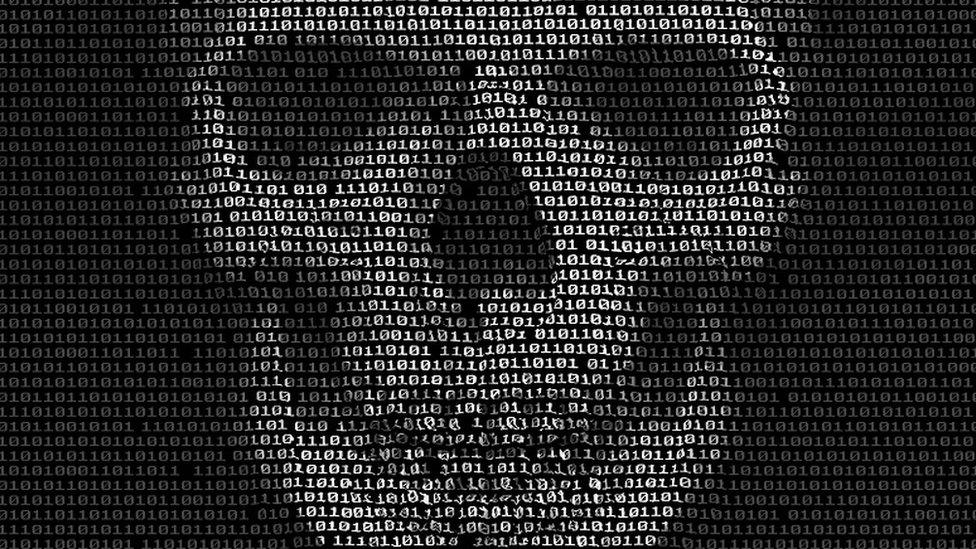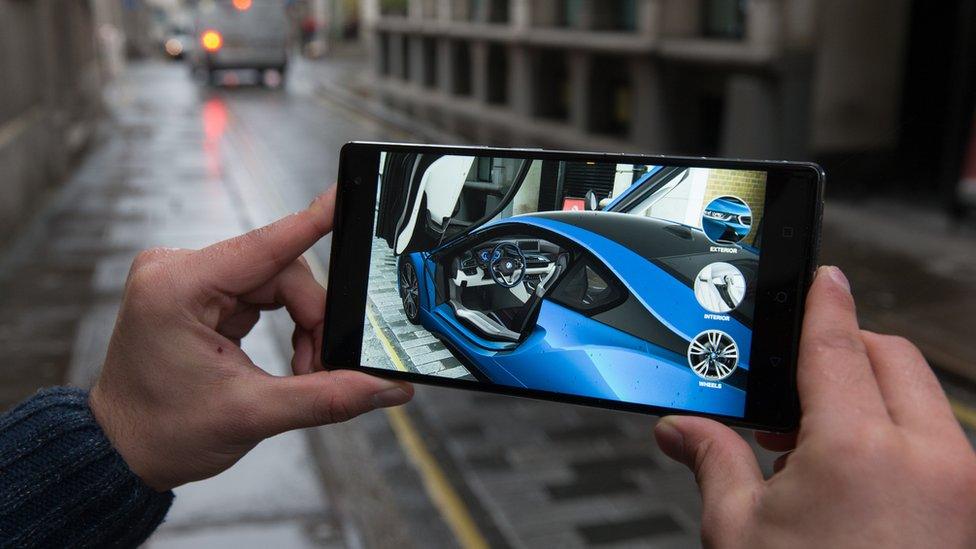2017 tech trends: 'A major bank will fail'
- Published

Could a bank go under following a major hacking theft in 2017?
If 2016 seemed politically tumultuous, 2017 promises to be equally tumultuous on the technology front.
The pace of change is accelerating at a dizzying rate, with profound implications for the way we work, play and communicate.
So what are the big technology trends to watch out for in 2017?
Cybersecurity
Cybersecurity will undoubtedly be the dominant theme of 2017, as all tech innovations could be undermined by data thefts, fraud and cyber propaganda.
Forget Kim Kardashian, it's hacking that could break the internet - and much more besides.
As accusations of Russian interference in the 2016 US presidential election continue to reverberate around the world, hackers - whether private or state-sponsored - would seem to be getting the upper hand.
Prof Richard Benham, chairman of the National Cyber Management Centre, gives a dire warning: "A major bank will fail as a result of a cyber-attack in 2017 leading to a loss of confidence and a run on that bank."
In November last year, hackers stole £2.5m from 9,000 Tesco Bank customers in a raid the UK's Financial Conduct Authority described as "unprecedented".

Last year Tesco Bank seemed to be offering free cash withdrawals to hackers, too
And the more connected the world becomes - think connected cars, smart homes, sensor-laden cities - the more opportunities for hackers to break into the system and wreak havoc.
"The internet of things (IoT) and industrial internet of things (IIoT) will play a larger role in targeted attacks in 2017," says Raimund Genes, chief technology officer at cybersecurity company Trend Micro.
"These attacks will capitalise upon the growing acceptance of connected devices by exploiting vulnerabilities and unsecured systems to disrupt business processes, as we saw with Mirai."
The firm also predicts that throughout 2017 criminals will continue renting out their ransomware infrastructures - the tools that enable hackers to break in to your system, encrypt all your data, then demand a ransom to decrypt it.
Hackers can achieve the same result by knocking out your website or factory control systems in a DDoS [distributed denial of service] attack - flooding your computer servers with so many requests that they cease functioning.
And hackers are not just interested in stealing data and making money from it, warns Jason Hart, chief technology officer in charge of data protection at Gemalto, a digital security company.

Are hackers beginning to get the upper hand?
They're altering it, with potentially dire consequences.
"It's scary, but data integrity attacks have the power to bring down an entire company and beyond; entire stock markets could be poisoned and collapsed by faulty data.
"The power grid and other IoT systems, from traffic lights to the water supply, could be severely disrupted if the data they run on were to be altered," he says.
As well as poorly secured devices, gullible humans will continue to be targeted, with so-called "business email compromise" fraud continuing to reap rich rewards for criminals, experts predict.
Simply tricking employees in to transferring funds to criminals' bank accounts is lo-tech but surprisingly effective, with Trend Micro reporting that the average payout in the US was $140,000 (£114,000) last year.
"Cybercriminals are targeting human vulnerabilities," says Prof Benham. "Millions is being spent on technology, but nothing on awareness training."
Artificial intelligence
AI was the buzzword of 2016 and looks set to dominate 2017 as well - for better or worse.
Enabling machines to learn, adapt to new circumstances and make decisions for themselves, rather than simply obeying pre-programmed instructions or algorithms, seems to present as many disadvantages as advantages.
The pessimists envisage self-programming machines running amok and breaking free of human control, with potentially apocalyptic consequences.
Rory Cellan-Jones meets the Alexa-powered robot Lynx
But optimists believe that applying a more restrictive, less autonomous form of machine learning to the wealth of data we are now generating and storing in the cloud could help identify correlations and patterns that were impossible for humans to see before.
And as more devices and sensors become connected, we will learn even more about the world around us. This ability to make sense of all this data could help us cure disease, tackle climate change, grow food more efficiently and generally run our lives in a much smarter, more sustainable way, proponents believe.
Lots was made of customer service chatbots last year, sometimes described erroneously as AI in action, but most of these were actually pretty dumb, merely guessing the most likely answer to fit the question.
Real AI, underpinned by natural language processing, neural networks and machine learning, will understand how humans think, talk, and categorise concepts, making it smarter and easier to interact with.
And the more people who use it, the more data it will have to learn from and the better it will become.
So we are likely to see a proliferation of smarter virtual assistants, such as Amazon's Alexa, Google's Assistant, Microsoft's Cortana, Apple's Siri, and newcomers like Viv.
Olly the robot develops a different personality to suit each of its users
Businesses will use their own versions of these AI assistants to make sense of all the data they now have to cope with.
"With AI we have the opportunity to build decision-support systems that see, hear, understand and collaborate with us to help make decisions faster, more relevant and better informed," says Gayle Sheppard, general manager of Saffron Technology, an Intel-owned cognitive computing firm.
Of course, these always-on listening devices connected to the cloud pose another potential security threat, not to mention privacy concerns over what happens to all the data they're hoovering up.
And another worry about AI is that hackers will have access to it as well - it's a cybersecurity arms race.
"AI will power malware, and will use data from the target to send phishing emails that replicate human mannerisms and content," warns Andy Powell, head of cybersecurity at Capgemini UK, an IT consultancy.
"Seeming more lifelike, these AI powered attacks will resonate with the target better than ever before, meaning they'll be more likely to fall victim."
There's simply no escaping the cybersecurity issue in 2017.
Augmented and virtual reality
While Pokemon Go showed how augmented or mixed reality tech could take the mobile gaming world by storm, 2017 is likely to see more businesses adopting the technology, too.
The marketing opportunities are obvious, with companies like BMW linking up with Accenture and Google Tango to create an app that lets customers visualise what various car models would look like in real-world situations.

Augmented reality applications should grow in popularity this year
Lots of other retailers will be using it to enhance their marketing.
But there are plenty of industrial and educational applications, too, with smart glasses and head-up displays enabling workers to follow instructions, read manuals and navigate workplaces more efficiently.
Virtual reality is still primarily for gaming, but when lighter, faster headsets are combined with haptic technologies, training and teaching applications will become more viable, too.
Automation
As AI increasingly takes over from call centre and customer service staff, and automation continues its takeover of manufacturing, the big question is what new jobs there will be for all these redundant workers.
We've already seen how the effects of globalisation and automation have stirred up voters in the US and potentially across Europe this year.

If robots are going to take many of our jobs, what are we going to do instead?
Could there be a new Luddite revolution brewing? After all, who benefits most from cheaper production? It's certainly not the poor.
"We're going to start confronting some hard truths about technology and the labour force," says Tien Tzuo, founder of subscription technology platform Zuora.
"We're going to have to figure out how to create jobs for people in this new economy, and if there literally are going to be fewer jobs, then we'll need to establish some sort of living standard or basic income for people."
So 2017 could also be the year the world is forced to deal - finally - with the tangible impacts of technology upon human society.
Follow Matthew on Twitter, external and Facebook, external.